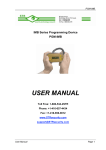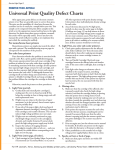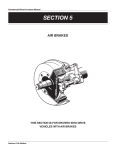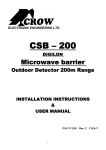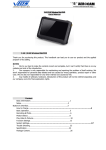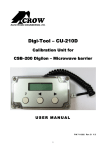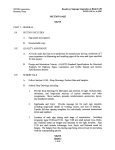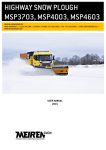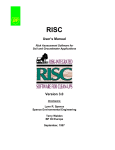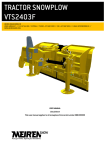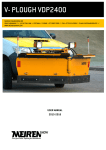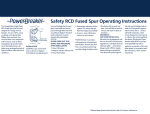Download R-300 User Manual 1.2
Transcript
R-300 Microwave Perimeter Protection Detector R-300 USER MANUAL US Toll Free: 1 -886-534-2STR Phone: +1-416-657-4434 Fax: +1-416-650-9012 www.STRsecurity.com [email protected] Revision 1.2_______________________________________________________05.07.2005 User Manual Page 1 R-300 Contents Introduction 1. Description and operation 1.1 Detector’ application 1.2 Detector’ technical specifications 1.3 Detector’ structure 1.4 Marking and sealing 1.5 Packaging 2. Detector proper usage 2.1 Pre -installation operations 2.2. Detector application 3. Maintenance 4. Storage 5. Transportation 6. Utilization This operation manual contains information concerning application, design, operation, technical specifications, structure of microwave barrier R300 (hereinafter “Detector”) and installation and maintenance instructions necessary for the most effective usage of its technical potential. Attention! 1. Manufacturer constantly works at detector upgrade, so some modifications may be made which, however, does not affect its normal function. TM 2. Detector uses the new technology “DIGILON “ facilitating its operation. It is recommended to read this manual before detector installation. User Manual Page 2 R-300 The abbreviations used in the manual are the following: RC – remote control PSU- power supply unit DZ- detection zone IAK- installation assembly kit IS- initial settings TMR - transmitter RCR - receiver CP - control panel 1. Description and operation 1.1. Detector application. The detector is intended to be used as alarm detector and provides the detection of a human crossing the detection zone. The detector is designed to operate 24-hour in outdoor conditions with temperature range from – 40 up to + 65 C, 100% relative humidity at +25 C air temperature. Detector is supplied from 12 – 27V DC PSU. 1.2 Detector technical specifications 1.2.1 The detector provides 24-hour outdoor operation and is able to withstand the following weather and terrain conditions: -precipitation (rain, snow) -solar radiation -wind with speed no more than 30m/s -surface irregularities with height no more than +/- 3m -grass height up to 0.3m User Manual Page 3 R-300 -snow height up to 0.5 m (without additional adjustments) 1.2.2 The detector’s DZ length is from 10 up to 300 m (measured by received signal with not less than 9 dB level). 1.2.3 DZ height in its centre is not less than 2 m (at maximum DZ length). 1.2.4 The detector generates alarm signal in form of output circuit open state and duration not less than 2s when: 1) A walking or crawling human crosses DZ with 0.1 -10 m/s speed; 2) Impulse with 5-30 V amplitude and more than 0.5s duration is applied to the transmitter remote control input (RC); 3) PSU is failed or its voltage is less than 10V; 4) RCR case is opened; 5) Any of the detector’s units fails; 6) Receiver’s normal operation is disturbed by trespasser using external electromagnetic field; 1.2.5 Detector’s output circuit of provides current switching up to 0.1 A at 72 V. 1.2.6 RC input resistance s is 10 k. 1.2.7 The detector normal operation is provided by 10-30 V DC power supply unit. 1.2.8. Detector’s current consumption is no more than 70mA at 24V DC. 1.2.9 Detector size (without initial assembly kit IAK) is 160 x115 x 45 mm 1.2.10 Detector weight (without IAK) is not more than 0,5 kg 1.2.11 Working frequency is 9500+/-200 MHz 1.2.12 Detector generates 7 different messages: User Manual Page 4 R-300 1) “Alarm”- the indicator is glowing and contacts of output relay are open for not less than 2 s, but no more than 30 s, tamper switch contacts are closed; 2) “Protection”- the indicator is not glowing, contacts of output relay and tamper switch are closed; 3) “Power supply voltage deficiency”- the indicator blinks with 2 s period (1 sec flashes and 1 sec is off), contacts of output relay are open (for more than 30 sec), tamper switch contacts are closed. 4) “Unacceptable IS parameters”( receiving signal level margin is less than 9 dB) - Indicator blinks with 2 sec period (0.25 sec flashes, 1,75sec is off) ,contacts of output relay are open, tamper switch contacts are closed; 5) “Defect” –the indicator on control panel is glowing, contacts of output relay are open (for more than 30 sec); tamper switch contacts are closed. 6) “Breaking in”- tamper switch contacts are open. 7) ‘Normal operation”- if 5-30 V and 0.5 sec duration pulse is applied to the detector RC input the indicator glows, contacts of output relay are open (for 2-3 sec), tamper switch contacts are closed. 1.2.13 The detector is ready for operation after power supply turns on - less than 30 sec. The detector does not generate alarm signal before switching to stand -by mode. 1.2.14 The detector recovery time after alarm signal termination – not more than 10 sec. 1.2.15 The adjustment mechanism provides turning of the detector units to +/- 15 degree angle in any plane. 1.2.16 The detector operates normally and does not generate false alarm signal when it is separately influenced by the following sources of interference: 1) Moving human at the following distances from protected zone axis: User Manual - not less than 3 m if PZ is 300 m, - not less than 2 m if PZ is 200 m, - not less than 1.5 m if PZ is 100 m. Page 5 R-300 2) Moving transport at the following distances from protected zone axis: - not less than 4.5 m if PZ is 300 m, - not less than 3.2 m if PZ is 200 m, - not less than 1,8 m if PZ is 100 m. 3) Moving single small animal (bird) in protected zone at a distance not less than 5 meters from detector’s units. 4) Ultra short waves radio stations broadcasting in 150-175 MHz frequency band with up to 40 W output power at a distance not less than 5 m from detector’s units. 1.2.17 The detector is protected from power supply positive and negative poles confusion (as a result of personnel mistake) and from 1000 V pulses with up to 1 ms duration caused by storm and picked by connection wires. 1.2.21 Average detector life time is not less than 8 years. 1.3 Detector’ structure 1.3.1 Principle of operation The TMR sends electromagnetic waves to the RCR. The RCR analyzes amplitude and temporal features of the received signal and in case these features are in coincidence with those embedded in “intruder” model processing algorithm the detector outputs alarm signal. Attention! The detector “R-300” belongs to linear (perimeter) detection devices. In contrast to volumetric detection devices which are able to detect movement of the intruder within the protected zone, “R-300” generate s alarm signal on crossing the protected zone by intruder. Therefore, for the detector “R-300” the alienation zone width is standardized (not the protected zone width). User Manual For moving humans and transport the Page 6 R-300 alienation zone width is determined outside which the detector would not generate the alarm signal. The shape of the protected zone is shown on picture 1.1. 1.3.2. Description of the detector’s functional chart. 1.3.2.1 The functional chart of the detector is shown on picture 1.2 TMR and RCR are located at the opposite sides of the protected zone. All external TMR and RCR circuits have built-in unattended lightning guards. These devices as well as power supplies are not shown on the functional chart. User Manual Page 7 R-300 User Manual Page 8 R-300 The TMR includes modulator, transmitting microwave module and selector of remote control (RC) signal. The modulator generates impulses which are supplied to the microwave module. The RC selector standardizes level of the signal applying to the according TMR input and provides proper selection between signal and interference. The RCR contains receiving microwave module, processor, executive device, indicator and case breakage sensor. The microwave module receives electromagnetic emission signal, detects and amplifies it. The processor fulfills the following operations: - controls microwave module in order to provide the optimization the received signal; - determines optimal threshold detection parameters and checks input signal compliance to these determined parameters; - checks power supply voltage; - checks executive device and indicator; The execution unit is solid-state relay which is, unlike electro-mechanic relays, more reliable and has practically unlimited life-time. The indicator is a service device and provides the indication of all detector’ modes of operation. When TMR receives RC signal, the modulator stops applying impulses to microwave module. Alarm signal is generated as a result. 1.3.2 Detector’ design 1.3.2.1 The detector is implemented as two separate units which are similar in form and size. 1.3.2.2 Receiver’ design (picture 1.3) User Manual Page 9 R-300 The bearing structure of the RCR is the basis of its case. Microwave module and processor PCB are fastened on the basis covered by the cover plate. Adjustment and indication controls as well as the contacts for control panel zone termination component can be accessed when the cover is opened. TRM and RCR connection is provided via cable termination on the basis. RCR is installed on the pipe and fastened with the bracket and two buckles from ISA. Picture 1.3 The location and marking of the contacts, adjustment and indication controls are shown on the picture 1.4. User Manual Page 10 R-300 Picture 1.4 Function of controls and indication: HL1 – detector’ modes of operation indicator TAMPER- tamper switch X4 (“1” and “2”) - contacts of sensitivity change bridge (initial position”1” corresponds the lowest sensitivity). 1.3.2.3 Transmitter’ design TMR and RCR have similar design. The only difference is that instead of the processor PCB modulator PCB is installed on the case basis. Modulator PCB doesn’t have controls and indication. The TRM opening during normal operation is not provided. Marking and location of contacts are shown on picture 1.5. Picture 1.5 1.4 Marking and sealing 1.4.1 Marking of TMR and RCR includes: User Manual the manufacturer’ logo and TMR and RCR labels; Page 11 R-300 1.4.2 - manufacturer’ TMR and RCR serial numbers; - production year and quarter. Package marking includes: - name of the detector; - manufacturer’ logo; - detector’s serial number; - year and month of packing. 1.5 Packaging 1.5.1 The detector is packed in cardboard box. 2. Detector’ proper usage 2.1 Pre-installation operations 2.1.1 Safety measures The safety measures and electrical code should be taken into consideration when running the detector in. The detector’ level of radiation allows to run the system without time restrictions. 2.1.2 Requirements to installation site 2.1.2.1 Actual detector location on the site should be in accordance with the equipment scheme. ATTENTION! STABLE OPERATION OF THE DETECTOR DEPENDS ON MEETING THE FOLLOWING REQUIREMENTS! 2.1.2.2 Buffer zone is determined providing the reliable detector operation. The following conditions should be taken into consideration: - The maximum height of the ground surface irregularities relating to the straight line between the bases of TMR and RCR stands should not be more than +/- 0.3m; - Bushes, trees, big objects and buildings are not allowed; - Acceptable grass level should not be more than 0.3m; - Acceptable snow level should not be more than 0.7m. The detector is able to operate when the snow level is more than 0,7m but it should be taken into consideration that it may not detect a human moving in the snow. User Manual Page 12 R-300 - No moving humans, transport or animals are allowed in the protected zone. Notice: 1) Installation of detector is allowed along obstruction surfaces and walls of buildings. In this case acceptable surface irregularities should not be more than 0,3m. The distance from any surface to the detector installation location should be 0,7 -1,3 m. Water flow from the roof nearby detector ( up to 5 m from the PZ axis) should be excluded. PZ overcoming by jumping from these constructions should also be excluded. 2) To detect the climbing trespasser it allowed to install the detector on top of the obstructive walls when the following conditions are met: the height of the installed detector units should be not less than 0,2 m from the top of the barrier and not less than 2m from the ground surface, maximum sector length is 150m (two times less than it was mentioned in 1.2.2), distance between top of the barrier and detector units across should not be less than 0,2 m. Barrier immobility should be provided along with immobility detector units relating to the barrier. 3) There are no special requirements to the area located outside radio nontransparent (metal, reinforced concrete) barriers. 4) If the requirements of 2.1.2.2 are not met it may deteriorate technical features of the detector. In such case acceptability of the detector application under actual conditions should be determined by operation testing. Shape and size of the alienation zone depending on the distance between TMR and RCR are shown on picture 2.1 User Manual Page 13 R-300 2.1.2.3 To eliminate the interference influence to detector’s normal operation along railways and highways it is recommended to extend 1.5-2 times the distances mentioned in 6 (1.2.17). 2.1.2.4 Units of the detector should be installed at a distance not less than 20m and 30 m away from power lines when the voltage is, accordingly, up to 35kV and up to 500kV. Connection lines should be laid underground when they run parallel to power lines. 2.1.2.5 In case of serial installation of several detectors the protected zone overcoming under or above installed units could be avoided by ”overlapping” of adjacent sectors for not less than 2m along protected zone axis. The installation samples for adjacent sectors are shown in pictures 2.2, 2.3 and 2.4. Picture 2.2 User Manual Page 14 R-300 Picture 2.3 Picture 2.4 2.1.3. Detector’ mounting 2.1.3.1 Installation of the detector should provide free access to its controls and fastening elements. 2.1.3.2 It is recommended to lay connection cables underground. Cables may be laid along walls and blocks in metal pipes or ducts. 2.1.3.3 Connection clamps, controls and indication can be accessed by turning off four screws on the basis and removing the cover. User Manual Page 15 R-300 2.1.3.4 In snowy areas (snow level more than 0,5m) the outer part of the detector installation poles should be no less than 1,5m. In less snowy areas the length of the outer part of the pole may be 1m. Detector units should be installed at a height of 0.8-0.9 m from the ground surface to the unit center. The unit bracket on the pole should be oriented so that normal line to the detector’s cover would be directed towards second unit. Bracket and two additional buckles from IAK should be used when detector units are installed on the round pole. 2.1.3.5 Detector’ units connections should be made according to Tables 2.1 and 2.2 Table 2.1 – RCR connection # Marking of contacts Functions of contacts 1 + Power supply “positive” 2 - Power supply “negative” 3, ?? 4 5,6 Output relay contacts ?? Tamper switch contacts Table 2.2 – TMR connection # Marking of contacts Functions of contacts User Manual Page 16 R-300 1 + Power supply “plus” 2 - Power minus 3 TEST RC contact The example of RCR connection in case of output relay and tamper switch integration in one circuit is shown on picture 2.5. R – terminal resistor of the control panel zone. ATTENTION! RESISTANCE MEASUREMENTS OF THE CONNECTION CABLES CURRENT-CARRYING WIRES AND ISOLATION SHOULD BE PERFORMED ONLY AFTER POWER SUPPLY SWITCHING-OFF AND DISCONNECTION OF THE ACCORDING CABLES. User Manual Page 17 R-300 Picture 2.5 2.1.4 Detector activation 2.1.4.1 Switch on the power supply and measure the voltage on respective unit terminals. The measured value with sufficient exploitation margin should be 11.5-28 V. For detector normal operation the supply voltage should correspond to the values defined in 1.2.7. 2.1.4.2. Remove the RCR cover and during 1-2 min check the indicator status eliminating any impact on the detector. In normal stand -by mode the indicator should not be glowing. Notice: 1) Modes of detector operation and the according indicator statuses are listed in 1.2.12. 2) If the indicator displays the mode “Unacceptable IS parameters” (receivi ng signal level margin is less than 9 dB) it is necessary to provide visual evaluation of installation and operation conditions to the requirements compliance. The detector operation in this mode is acceptable but stability under significant environment changes and other exposures cannot be provided. 2.1.4.3 Check the proper detector operation using the RCR indicator by PZ testing crosses along its whole length. The actual cross locations should be in hollows and on heights. After the test close RCR’ cover. 2.1.4.4 Apply 5-30 V to TMR terminals “RC”, the detector should generate alarm signal. User Manual Page 18 R-300 2.1.4.5 Running in the detector means 24-hour test running during not less than 3 days with registration of all alarms and the follow-up analysis. During running in it is recommended, not less than two times per day, to fulfill the testing PZ crosses. If during running in operation and testing crosses the false alarms and missing trespasser accordingly occur it is necessary to eliminate revealed defects with the aid of indications of 2.2.1. 2.2 Detector application 2.2.1 List of possible defects and troubleshooting Main possible defects and troubleshooting are listed in Table 2.3. Table 2.3 Defect Possible Troubleshooting reasons of defect 1.Detector RCR does Check RCR supply constantly not have voltage, check power generates power supply connection alarm signal, supply cable and PSU. RCR is RCR should be defective replaced 2. Detector The control Check the circuit by constantly panel “ringing out”, check if generates alarm zone the control panel zone alarm signal, circuit is termination resistor is indicator is not failure. installed properly. RCR cover Check if the cover was improper installed correctly. indicator is not glowing glowing but shortly flashes (2 sec) while User Manual installation. Page 19 R-300 crossing the RCR is RCR should be protected defective. replaced. 3. Detector Detector Visually check the does not has not compliance of generate alarm been installation and signal while the installed in exploitation conditions protected zone accordanc with 1.2.1and 2.1.2. If is crossed by e with the sector cannot meet trespasser. operating the requirements switch manual bridge to position‘1” of requiremen sensitivity mode and ts. perform crossing test. RCR is RCR should be defective replaced TRM is TRM should be defective replaced zone. Defect Possible troubleshooting reasons of defect 4.False alarm is Detector has not Visually check generated too been installed in the compli ance often accordance with of installation and operating exploitation manual conditions with requirements 1.2.1and 2.1.2. Unstable Check the User Manual Page 20 R-300 operation of contacts power supply reliability and unit or high level accuracy of ripples of power power supply supply voltage lines layout. Check PSU by test using different PSU that is certainly in order. Defective RC Disconnect RC circuit circuit from detector and perform test without RC. Defective RCR Replace or TMR defective unit. Notice: The TMR or RCR failure is determined by its replacement to the certainly good one with following exploitation test. 3. Maintenance 3.1 Regular maintenance is crucial for proper detector operation. Table 3.1 shows the frequency and volume of maintenance work that should be performed. Table 3.1 List of Monthly maintenance Yearly Maintenance description operations 1. Checking the User Manual + 3.2.1 Page 21 R-300 condition of a sector in alienation zone 2. External 3.2.2 examination of the detector + Notice 1. After winter storms, heavy showers, hurricanes, and also in case of intense growth of vegetation it is recommended to perform maintenance operations monthly. 2. Electrical contacts check should be performed according to the general alarm systems maintenance operations. 3.2 Checking the condition of a sector in alienation zone 1) Visually check if the sector condition is in accordance with 2.1.2. Where needed chop off trees and bushes branches, cut the grass (taking into account the possible growth of the grass up to the next check up) and clean the sector from unnecessary objects. 2) In wintertime change the units’ height above the ground (if necessary) or remove snowdrifts along the sector. 3.3 External examination of the detector. 1) Check the tightness of the detector units fastening elements. 2) Check if there is any dust or dirt on the detector. Clean determined spots with wet rag. Degrease the surface with solvent soaked tissue. User Manual Page 22 R-300 4. Storage Detectors should be stored packaged in storage facilities with the air temperature from +5 up to +30 C and relative humidity not more than 85%. Aggressive environments are not permitted. 5. Transportation Transportation of packaged detectors can be made by any transport in compartments with roof at the distance up to 10 000 km. Boxes should be stowed in such way that would allow to sustain shoves. Warranty Information / Terms & Conditions STR International Inc herein referred to as “STR.” LIMITED WARRANTY STR hereby warrants, subject to the conditions here in below, that should this product become defective by reason of improper workmanship or material defect during the specified warranty period, STR will repair the same, effecting all necessary parts without charge for either parts or labor, or replace the unit at STR option. Labor: ONE (3) Years from the date of original purchase from authorized Re -seller unless otherwise specified. Parts: ONE (1) Year from the date of original purchase from authorized Re -seller unless otherwise specified. Void Warranty Purchaser warranty will be void and purchaser waves any rights to make warranty claim if product has been opened, altered or modified, repaired or serviced by anyone, other then the service facilities authorized by STR to render such services. Further, the seal/serial number on the unit must not have been altered or removed. The unit must not have been subject to accident, misuse, and abuse or operated contrary to the instructions provided. The opinion of STR with respect to this matter shall be final. This warranty does not include and is not extended to broken and damaged accessories, batteries and to parts wearing out due to normal wear and tear. User Manual Page 23 R-300 Proper Delivery: Returned products will not be accepted for warranty repair unless accompanied with a valid Return Merchandise Authorization (RMA) number issued by STR. RMA numbers issued by STR are valid for 15 days. Shipments received after 15 days will be refused. The unit must be shipped, freight prepaid or delivered to the STR service facility, in either its original package or similar package, affording an equal degree of protection and with instructions indicating the location within Canada or the United States to which the unit will be returned. The repaired unit will be returned to the customer freight prepaid unless the warranty claim is deemed void or invalid. All accessories included with the unit must be listed individually on the packing slip for the shipping documentation. STR will not accept any liability, for loss or damage to such accessories if they are not listed. Proof of Purchase Date: This warranty applies and commences to STR products, from the original date of purchase from an Authorized Re-seller. Proof of purchase (i.e.: photocopy of invoice), must be included with product when submitting for warranty repair. Warranty Limitations: This warranty does not cover maintenance or check-ups, if required. This warranty gives you specific legal rights and you may also have other rights, which vary from state/province to state/province. Some states/provinces do not allow the exclusion or limitation of incidental or consequential damages or limitations on how long an implied warranty lasts, therefore the above exclusions or limitations may not apply to you. STR is not responsible or liable for indirect, special, incidental or consequential damages arising out of or in connection with, the use or performance of the product or other damages with respect to loss of property, loss of revenues or profit, or cost of removal, installation or reinstallation. PRODUCT RETURNS 30 Day Product Return Policy ** If you are not satisfied with a product, you may return it to STR within 30 days from original date of shipment within the following conditions: ? Original shipping charges are not refundable unless deemed that STR shipped incorrect item(s), incorrect quantity (ies) or original manufacturers defective product ( subject to STR validation ). ? Returned products will not be accepted unless accompanied with a valid Return Merchandise Authorization number (RMA). ? RMA numbers issued by STR are valid for 15 days. Shipments received after 15 days will be refused. ? Returns must include a copy of original invoice, the completed STR packing slip, and a detailed statement of reason for return. ? Customer is responsible for all freight charges, duties and taxes, if applicable. Product must be properly packaged and shipped, Prepaid to STR in its original packaging, or similar packaging that offers an equal degree of protection. STR will charge the full replacement cost for any missing components or parts. STR is not responsible for lost or damaged merchandise. We strongly recommend insuring products for return shipping. User Manual Page 24 R-300 ? Return claims are void if manufacturer’s seal is broken and/or products are altered or modified, subjected to an accident, improper handling, improper installation, misuse and abuse or operated contrary to the operating instructions. Products returned that are not in “re-saleable” condition will be returned to customer at their expense. ? Discontinued items, special or custom-made equipment items (items not carried as stock even though they may appear on price lists) may not be returned. Returned products will be evaluated at the original purchase price and not at any subsequent price increase or decrease. ** Subject to the conditions stated above, the following re-stocking fees will apply to products returned for credit/refund. STR reserves the right to determine the validity of the product returned and / or refuse to accept product for credit. 0 % Re -Stocking Fee (less original shipping charges): If product is returned within 30 days from original STR ship date. 25% Re -Stocking Fee (less original shipping charges): If product is returned within 60 days from original STR ship date. 50% Re -Stocking Fee (less original shipping charges): If product is returned within 90 days from original STR ship date. 100% Re-Stocking Fee ( 0% credit ) : If product is returned after 90 days from original STR ship date. DISCLAIMER In no event will STR or any of its affiliates be liable for any indirect, special, punitive, consequential liability, or incidental damages upon any basis of liability whatsoever even if advised of the possibility of such damages. In addition, STR does not take any responsibility or assume any liability for the wiring, installation or placement of the equipment Customer purchases, or for the activities of any other individual or entity such as Customer’s Company, those who prepare the specifications or any local Authorities who inspect or approve Customer’s installation. PRIVACY POLICY STR does not collect personally identifying information about you except when you specifically provide it to us. Forms you may fill out that request personal information such as your mailing address, telephone number, e-mail address, etc. will not be disclosed to any third party companies. www.STRsecurity.com is for information purposes. Distribution, duplication, modification or revision of the contents of this site is strictly prohibited without the explicit written permission of STR. STR is committed to safeguarding your privacy online. We only use your personal information to service your account, to provide you with the products you inquire about and request, and to inform you of additional products or services that may benefit you. User Manual Page 25


























